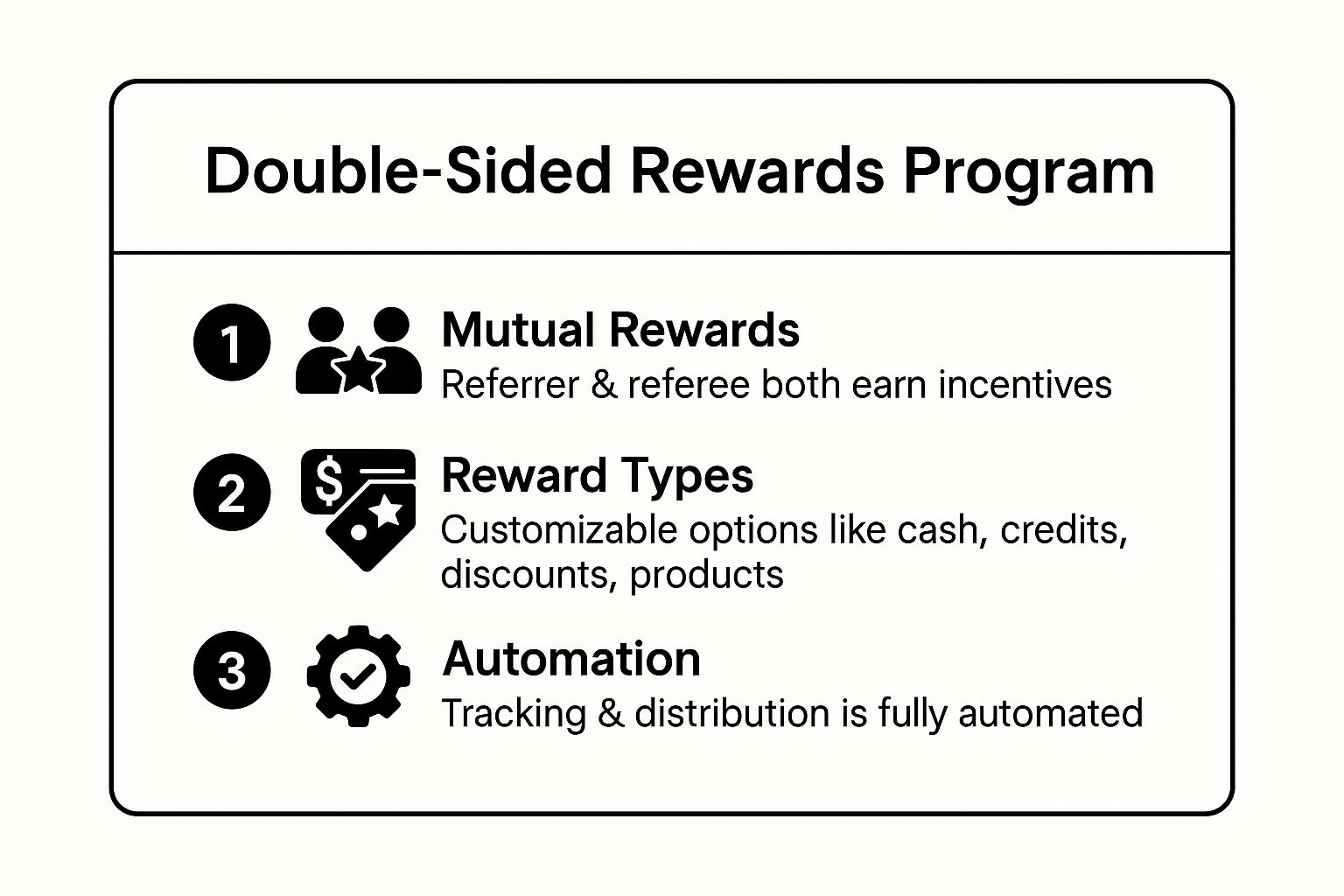Igniting SaaS Growth: Unleashing the Power of Referrals
Acquiring new customers is crucial for any SaaS business. This curated list provides nine actionable referral marketing strategies specifically designed for SaaS and product-led growth companies. Learn how to transform your existing users into a powerful acquisition channel and fuel organic growth. We'll explore practical implementation details, and illustrate how Refgrow, a fully embeddable affiliate software, can seamlessly integrate these strategies within your product.
Referral programs are more than just a growth hack; they tap into the inherent trust between individuals. When a satisfied customer recommends your product, it carries far more weight than any advertisement. referral marketing is a powerful strategy. Effectively leveraging this trust can significantly reduce your customer acquisition cost (CAC) and boost your bottom line. This list offers a diverse range of approaches, from classic double-sided rewards to innovative gamified programs and strategic partnerships. You’ll discover how to:**
- Incentivize social sharing
- Structure tiered commissions
- Build engaging referral competitions
- Leverage influencers
- Implement employee referral programs
- Create exclusive VIP experiences
- Explore cross-brand partnerships
- Offer cashback rewards
This article dives deep into each strategy, offering concrete examples and actionable tips. Whether you're an early-stage startup or a seasoned SaaS founder, this guide will provide you with the tools to ignite sustainable growth through the power of referrals. (Source: Glossary - Referral Marketing from PlusVibe)
1. Double-Sided Rewards Program
A double-sided rewards program, a cornerstone of successful referral marketing strategies, incentivizes both the referrer (existing customer) and the referee (new customer) when a referral leads to a conversion. This strategy fosters a sense of mutual benefit, boosting participation and creating a win-win scenario for everyone involved. It transforms the referral process from a simple ask into a valuable exchange. By rewarding both parties, you acknowledge the referrer's effort and offer an enticing welcome to the new customer.
Dropbox's iconic "Get 500MB for each friend who joins" campaign perfectly illustrates this strategy's power. Other successful examples include Uber's ride credits for both driver and passenger referrals, Airbnb's travel credits for hosts and guests, and PayPal's early adoption of a "$10 for both" model. These programs leveraged the power of mutual benefit to drive rapid growth.
Implementing a Double-Sided Rewards Program
Consider these tips when implementing a double-sided rewards program:
- Valuable and Sustainable Rewards: Offer rewards that are enticing to your target audience without jeopardizing your profit margins.
- Clear Terms and Conditions: Establish transparent rules to prevent abuse and ensure fairness.
- Tiered Rewards: Encourage multiple referrals by offering increasingly attractive rewards for subsequent successful referrals.
- Reward Type Testing: Experiment with various reward types (cash, discounts, free products, exclusive access) to determine what resonates best with your audience.
This approach is particularly effective for product-led growth SaaS companies and early-stage startups seeking rapid customer acquisition. By leveraging the network effects of satisfied customers, you can accelerate growth organically. A double-sided program fuels word-of-mouth marketing and builds a loyal customer base.
The following infographic summarizes the key aspects of a double-sided rewards program, offering a quick reference for implementation. It highlights the mutual benefit, customizable reward options, and automated tracking capabilities that make this strategy so effective.

As the infographic highlights, automating the tracking and distribution of rewards streamlines the process for both your business and your customers. This automation allows for seamless scaling as your referral program grows. The ability to customize reward types ensures you can tailor your offerings to resonate with your specific target audience, maximizing engagement and conversion rates.
2. Social Media Sharing Incentives
Social media sharing incentives, a dynamic approach within referral marketing strategies, encourage customers to broadcast referral links and brand content across social platforms. This strategy offers rewards in exchange for this social amplification, effectively leveraging the viral nature of networks like Facebook, Instagram, and Twitter. It transforms satisfied customers into brand advocates, creating organic awareness and expanding the reach of referral programs. By incentivizing social sharing, businesses tap into pre-existing networks, reaching potential customers who are more likely to trust recommendations from their connections.

Tesla's referral program, offering exclusive rewards for social shares, exemplifies this strategy's effectiveness. Other examples include Morning Brew's premium content access for social sharing, Glossier's Instagram-driven referral campaigns, and Dollar Shave Club's viral social media referral content. These campaigns demonstrate the power of social sharing to drive both brand visibility and customer acquisition.
Implementing Social Media Sharing Incentives
Consider these tips when integrating social media sharing incentives:
- Create Shareable Content: Develop visually appealing and engaging content specifically designed for social media platforms.
- Platform-Specific Incentives: Tailor rewards and incentives to each platform. Consider offering unique bonuses for Instagram story shares or TikTok video creations.
- Hashtag Campaigns: Utilize relevant hashtags to expand the discoverability of your referral program and brand content.
- Engage and Respond: Actively monitor social mentions and respond to comments to build a strong online community and boost engagement.
This strategy is particularly valuable for SaaS companies and product-led businesses seeking to rapidly expand their reach and acquire new customers. By tapping into the organic reach of social media, businesses can cultivate brand awareness and drive word-of-mouth marketing in a cost-effective manner. Social media sharing incentives fuel viral growth and create a sense of community around your brand.
3. Tiered Commission Structure
A tiered commission structure, a powerful driver in referral marketing strategies, rewards referrers with increasingly attractive incentives based on the number or value of successful referrals. This strategy motivates high-performing advocates to continue promoting your brand by offering escalating rewards for reaching specific milestones. It transforms the referral process from a one-time action into an ongoing engagement. By recognizing and rewarding top referrers, you cultivate a community of brand ambassadors.
Successful examples of tiered commission structures include Amazon Associates' performance-based tiers, HubSpot's partner program with escalating benefits, and Shopify's affiliate program with tier-based commissions. ClickFunnels' Dream Car and vacation tier rewards further illustrate the potential of this strategy. These programs have demonstrably driven significant growth by motivating high-performing referrers. Learn more about setting up tiered structures effectively in our article on how to create an affiliate program: Learn more about...
Implementing a Tiered Commission Structure
Consider these tips when implementing a tiered commission structure:
- Achievable First-Tier Goals: Start with attainable goals to encourage initial participation and build momentum.
- Clear Progress Visibility: Provide referrers with transparent tracking and clear visibility into their progress toward the next reward tier. To streamline the process, consider leveraging social media automation tools for updates and communication.
- Diverse Rewards: Offer a mix of monetary and experiential rewards, especially at higher tiers, to cater to different motivations.
- Data-Driven Adjustments: Regularly review performance data and adjust tier thresholds and rewards based on program results.
This approach is particularly effective for SaaS businesses and early-stage startups looking to build a robust referral program and accelerate customer acquisition. By leveraging the enthusiasm of your most active referrers, you create a sustainable growth engine. A tiered structure fosters a sense of achievement and encourages ongoing participation, transforming satisfied customers into powerful brand advocates.
4. Gamified Referral Programs
Gamified referral programs, an innovative approach to referral marketing strategies, incorporate game-like elements to boost engagement. Think points, badges, leaderboards, and challenges woven into the referral process. This strategy taps into psychological motivators like competition and achievement, making referring friends more fun and rewarding, ultimately driving increased participation.

Successful examples include Starbucks Rewards with its star collection system, Nike Run Club's achievement-based sharing, and Duolingo's streak system coupled with friend challenges. Even Fitbit's step challenges and social competitions demonstrate the power of gamification. These programs leverage friendly competition and the desire for recognition to boost referral rates. For a deeper dive into best practices, learn more about gamified referral programs.
Implementing a Gamified Referral Program
Consider these tips when implementing a gamified referral program:
- Simple and Intuitive Game Mechanics: Avoid overly complex systems. Keep the rules clear and easy to understand.
- Balance Competition and Collaboration: Offer opportunities for both individual achievement and collaborative efforts.
- Regularly Introduce New Challenges: Maintain excitement and engagement by adding fresh challenges and rewards.
- Meaningful Rewards: Ensure rewards are valuable beyond just game elements. Consider tangible benefits like discounts or premium features.
This approach is particularly effective for SaaS companies aiming to build a strong community and foster viral growth. Gamification can transform a mundane referral ask into an exciting, interactive experience. By tapping into users' intrinsic motivations, you can significantly amplify your referral marketing results.
5. Influencer and Ambassador Programs
Influencer and ambassador programs represent a powerful referral marketing strategy that leverages the reach and trust of influential individuals to promote products or services. By partnering with social media influencers, brand ambassadors, and micro-influencers, businesses can tap into pre-existing, engaged audiences and drive referrals through authentic recommendations. This approach transforms marketing from a company-led broadcast into a personalized, trusted endorsement.
Successful examples of influencer marketing abound. Daniel Wellington’s micro-influencer watch campaigns, Gymshark's fitness influencer partnerships, Fashion Nova’s collaborations, and HelloFresh's food blogger ambassador program all demonstrate the power of this strategy. These brands effectively leveraged influencer credibility to generate significant brand awareness and drive sales.
Implementing an Influencer and Ambassador Program
Consider these tips when implementing an influencer program:
- Targeted Influencer Selection: Choose influencers whose audience aligns with your target market to ensure maximum relevance and impact.
- Authentic Collaboration: Provide clear guidelines while allowing influencers creative freedom to maintain authenticity and resonate with their followers.
- Performance Tracking: Track performance with unique codes, dedicated landing pages, and UTM parameters to measure the effectiveness of each partnership.
- Long-Term Relationships: Focus on building long-term relationships with influencers rather than one-off campaigns to foster deeper engagement and sustained results.
This approach is particularly effective for consumer-facing brands, lifestyle products, and companies seeking to expand their reach within specific niche markets. By leveraging the trust and authority of influencers, businesses can effectively amplify their message, build brand awareness, and drive valuable referrals. Influencer marketing adds a layer of social proof that traditional advertising often lacks. This authenticity resonates strongly with today’s consumers, making influencer programs a valuable tool for driving growth.
6. Employee Referral Programs
An employee referral program, a powerful internal referral marketing strategy, incentivizes company employees to refer qualified candidates for job openings or even customers for products/services. This strategy taps into employees' existing networks and their deep understanding of company culture and values to source high-quality referrals. It's a win-win: employees gain rewards, and the company benefits from pre-vetted candidates and potential customers.
Companies like Google, Salesforce, and Zappos have successfully leveraged employee referral programs. Google is well-known for its substantial referral bonuses. Salesforce fosters an "Ohana" (family) referral culture. Zappos emphasizes culture fit in its employee referrals. Microsoft also utilizes an internal rewards system for referrals, recognizing the value of employee networks. For programs involving influencers, measuring return on investment is crucial. More information can be found in this resource: ROI of Influencer Marketing (Source: ROI of Influencer Marketing: Your Complete Success Guide from viral.app).
Implementing an Employee Referral Program
Consider these tips when establishing an employee referral program:
- Meaningful Rewards: Offer rewards aligned with your company culture (e.g., bonuses, extra vacation time, company swag).
- User-Friendly Tools: Provide employees with easy-to-use referral platforms and clear guidelines.
- Success Stories: Regularly communicate program successes and highlight top referrers to boost morale and participation.
- Diversity and Inclusion: Ensure your program promotes diverse hiring practices and considers inclusivity.
This referral marketing strategy is particularly effective for companies seeking talent aligned with their values and mission. Early-stage startups can benefit significantly from leveraging employee networks to reach a wider pool of potential customers and candidates. By activating their employees as brand ambassadors, companies build stronger teams and a loyal customer base.
7. Exclusive Access and VIP Programs
Exclusive access and VIP programs, a powerful tactic among referral marketing strategies, reward successful referrers with unique perks. These can include access to products, services, events, or content unavailable to regular customers. This strategy cultivates a sense of exclusivity and status, motivating high-value customers to become enthusiastic brand advocates and effectively driving referral marketing. It transforms loyal customers into active participants in your growth.
Companies like Apple, Tesla, and American Express have effectively used this strategy. Apple's exclusive launch events for top customers, Tesla's early access programs for new vehicles, and American Express' exclusive events and experiences exemplify this approach. Sephora's tiered VIB program also demonstrates the power of exclusivity in driving engagement and loyalty through a structured reward system. These programs leverage the desire for unique experiences and recognition to drive referral behavior.
Implementing Exclusive Access and VIP Programs
Consider these tips when designing an exclusive access program as part of your referral marketing strategies:
- Genuine Value: Ensure the exclusive offerings provide truly unique value that resonates with your target audience.
- Clear Criteria: Establish transparent criteria for VIP status achievement tied to successful referrals.
- Fresh Content: Regularly refresh exclusive offerings to maintain interest and prevent stagnation.
- Balanced Approach: Balance exclusivity with inclusivity to avoid alienating non-VIP customers.
This approach is particularly effective for businesses with a strong community aspect or those selling high-value products/services. It caters to customers who value recognition and exclusivity, turning them into powerful brand advocates. By nurturing a sense of belonging and rewarding loyalty, exclusive access programs can amplify word-of-mouth marketing and boost customer lifetime value. Furthermore, these programs create a positive feedback loop: the more referrals a customer makes, the more exclusive benefits they unlock, further incentivizing referrals.
8. Partnership and Cross-Brand Referrals
Partnership and cross-brand referrals represent a collaborative referral marketing strategy where complementary businesses partner to refer customers to each other. This approach leverages existing customer relationships and trust between brands to create mutually beneficial referral opportunities, effectively expanding reach without direct competition. By tapping into an established customer base, businesses can access a highly qualified audience already predisposed to trust recommendations from a brand they value. This synergistic approach amplifies the reach of both partners, accelerating customer acquisition for each.
Successful examples of this strategy abound. Spotify and Uber’s partnership allowed users to control their Uber ride’s music through Spotify, exposing both brands to new audiences. Starbucks and Barnes & Noble’s in-store collaborations offered a combined coffee and book experience, appealing to both customer bases. Similarly, Chase and various airline frequent flyer programs leverage cross-brand referrals to offer travel rewards, and the Amazon Prime and Whole Foods integration provides exclusive discounts, incentivizing customer crossover. These collaborations demonstrate the power of leveraging aligned audiences for mutual benefit.
Implementing Partnership and Cross-Brand Referrals
Consider these tips when implementing a cross-brand referral program:
- Choose Aligned Partners: Select partners with similar values and audiences whose offerings complement, but don't compete with, your own.
- Clear Terms: Establish clear terms for customer sharing, attribution, and data privacy.
- Unique Joint Offerings: Create unique joint offerings that provide genuine value to both customer bases.
- Performance Evaluation: Regularly evaluate partnership performance and adjust strategies as needed.
This strategy is highly effective for businesses seeking to expand their reach into new, relevant markets. It's particularly beneficial for SaaS companies and early-stage startups looking to leverage established brand trust and accelerate customer acquisition. Learn more about Partnership and Cross-Brand Referrals for SaaS businesses. By working collaboratively, businesses can unlock significant growth potential and build stronger customer relationships.
9. Cashback and Financial Incentives
Cashback and financial incentives are a direct, monetary approach to referral marketing. This strategy rewards both the referrer and the referee with tangible financial benefits, such as cash rewards, account credits, or discounts, for successful referrals. This straightforward approach appeals to customers' desire for immediate value and is easily understood across demographics. It leverages the inherent motivational power of money to drive referral program participation.
Capital One's credit card referral cash bonuses, Robinhood's free stock referral program, and various bank account opening bonuses illustrate the effectiveness of this strategy. These programs tap into the universal appeal of financial gain, making it easy for customers to see the value in referring others. Charles Schwab also uses cash referral rewards to attract new clients, demonstrating the strategy's applicability across financial services.
Implementing Cashback and Financial Incentives
Consider these tips when implementing cashback and financial incentives:
- Set Meaningful but Sustainable Referral Amounts: Offer rewards that are attractive to your target audience without negatively impacting your profit margins.
- Fraud Detection and Prevention: Implement measures to detect and prevent fraudulent referral activity.
- Graduated Payouts: Consider offering tiered rewards based on the referee's lifetime value, incentivizing referrals of high-value customers.
- Clear Communication: Clearly communicate payout terms, timelines, and any associated conditions to manage expectations and ensure transparency.
This approach is particularly effective for financial services companies and businesses with a clear customer lifetime value. Early-stage startups can also benefit from this strategy by offering enticing cash incentives to quickly build their initial customer base. By directly rewarding customer acquisition, you can effectively incentivize word-of-mouth marketing and accelerate growth. The clarity and tangible nature of cashback rewards make this a compelling referral marketing strategy for many businesses.
Referral Marketing Strategies Comparison Matrix
| Referral Strategy | Implementation Complexity 🔄 | Resource Requirements ⚡ | Expected Outcomes 📊 | Ideal Use Cases 💡 | Key Advantages ⭐ |
|---|---|---|---|---|---|
| Double-Sided Rewards Program | Moderate to High due to tracking & fraud | Medium to High for rewards and automation | High participation and customer acquisition | SaaS, marketplaces, subscriptions with high LTV | Mutual rewards boost engagement and brand loyalty |
| Social Media Sharing Incentives | Moderate, requires platform integrations | Low to Medium, content creation focused | Wide reach, brand awareness with viral potential | Consumer brands, lifestyle, millennials & Gen Z | Cost-effective, leverages social networks |
| Tiered Commission Structure | High, complex tracking and management | Medium to High, analytics and rewards | Sustained advocacy and better ROI | B2B SaaS, high-ticket, brand advocates | Motivates top referrers with escalating incentives |
| Gamified Referral Programs | High, needs ongoing content updates | Medium, design and development intensive | Increased engagement through competition | Apps, fitness, education, youth-focused consumer goods | Fun, memorable; encourages repeat participation |
| Influencer and Ambassador Programs | High, management of partnerships needed | High, influencer fees and campaign support | Trusted referrals with targeted reach | Fashion, beauty, fitness, lifestyle consumer brands | Established audiences and credible endorsements |
| Employee Referral Programs | Moderate, integrated with HR systems | Medium, reward programs and tracking | Higher quality hires/customers and engagement | All companies, especially recruiting & B2B customer acquisition | Quality referrals and improved retention |
| Exclusive Access and VIP Programs | Moderate, requires exclusive content/events | Medium, experience and event costs | Strong emotional loyalty and advocacy | Premium, luxury brands, engaged customer communities | Builds exclusivity and emotional connection |
| Partnership and Cross-Brand Referrals | High, needs partner alignment and negotiation | Medium, shared marketing and coordination | Access to new segments and shared credibility | Service providers, subscription, complementary products | Leverages brand associations and shared resources |
| Cashback and Financial Incentives | Low to Moderate, straightforward payout setup | Medium to High due to direct monetary cost | Immediate tangible value, easy ROI tracking | Financial services, high-value products | Universal appeal and simple customer motivation |
Fueling Sustainable Growth: Embedding Referrals with Refgrow
This comprehensive guide has explored nine powerful referral marketing strategies tailored for SaaS and product-led businesses. From double-sided rewards and tiered commissions to gamified programs and strategic partnerships, we've examined diverse approaches to ignite growth through the power of word-of-mouth marketing. The key takeaway is this: successful referral programs are built upon a foundation of value exchange. By incentivizing both the referrer and the referred friend, you create a win-win scenario that fuels sustainable growth.
Mastering the Art of Referral Marketing
Mastering these strategies is crucial for several reasons. First, referrals generate higher quality leads compared to other marketing channels. Referred customers often exhibit higher lifetime value and lower churn rates. Second, referral marketing can significantly reduce customer acquisition costs, freeing up resources for other growth initiatives. Finally, a thriving referral program fosters a strong sense of community around your product, boosting brand loyalty and advocacy.
Key Takeaways for Implementation
Remember these essential points as you embark on your referral marketing journey:
- Personalization is paramount: Tailor your referral program to your specific target audience and product offering.
- Make it easy to participate: Frictionless sharing and clear instructions are crucial for maximizing engagement.
- Track and measure your results: Monitor key metrics like referral rate, conversion rate, and customer lifetime value to optimize your program over time.
- Continuously iterate and improve: A/B test different incentives, messaging, and program elements to find what works best for your audience.
The Power of Refgrow
Implementing a successful referral program often requires a dedicated platform to manage the complexities of tracking, rewards, and analytics. This is where Refgrow excels. Refgrow empowers you to seamlessly embed referral programs directly within your product, creating a native, frictionless experience for your users. By eliminating the need for external tools, you can transform your customers into active affiliates with minimal effort.
From Strategy to Action
The strategies outlined in this article provide a roadmap for building a thriving referral program. By understanding the principles of value exchange, gamification, and strategic partnerships, you can unlock the potential of your customer network to drive sustainable growth. Embrace the power of referrals, and watch your business flourish.
Ready to transform your customers into your best marketers? Refgrow simplifies the process of building and managing powerful referral programs that integrate seamlessly with your SaaS product. Visit Refgrow today to learn more and start fueling your growth through referrals.

